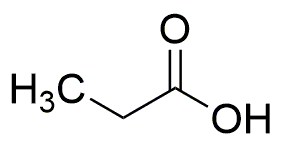Propionic acid is widely utilized in research focused on:
- Food Preservation: Commonly used as a preservative in baked goods and dairy products, it helps inhibit mold and bacterial growth, extending shelf life and maintaining food safety.
- Agriculture: Employed as a herbicide and fungicide, it effectively controls unwanted plant growth and fungal diseases, benefiting crop yield and quality.
- Pharmaceuticals: Serves as an important intermediate in the synthesis of various pharmaceuticals, enhancing the production of medications that treat a range of conditions.
- Animal Feed: Utilized as a feed additive, it promotes animal health by preventing spoilage and improving nutrient absorption, leading to better growth rates in livestock.
- Biochemical Research: Acts as a key reagent in biochemical assays and studies, facilitating research in metabolic pathways and organic synthesis.
General Information
Properties
Safety and Regulations
Applications
Propionic acid is widely utilized in research focused on:
- Food Preservation: Commonly used as a preservative in baked goods and dairy products, it helps inhibit mold and bacterial growth, extending shelf life and maintaining food safety.
- Agriculture: Employed as a herbicide and fungicide, it effectively controls unwanted plant growth and fungal diseases, benefiting crop yield and quality.
- Pharmaceuticals: Serves as an important intermediate in the synthesis of various pharmaceuticals, enhancing the production of medications that treat a range of conditions.
- Animal Feed: Utilized as a feed additive, it promotes animal health by preventing spoilage and improving nutrient absorption, leading to better growth rates in livestock.
- Biochemical Research: Acts as a key reagent in biochemical assays and studies, facilitating research in metabolic pathways and organic synthesis.
Documents
Safety Data Sheets (SDS)
The SDS provides comprehensive safety information on handling, storage, and disposal of the product.
Product Specification (PS)
The PS provides a comprehensive breakdown of the product’s properties, including chemical composition, physical state, purity, and storage requirements. It also details acceptable quality ranges and the product's intended applications.
Certificates of Analysis (COA)
Search for Certificates of Analysis (COA) by entering the products Lot Number. Lot and Batch Numbers can be found on a product’s label following the words ‘Lot’ or ‘Batch’.
*Catalog Number
*Lot Number
Certificates Of Origin (COO)
This COO confirms the country where the product was manufactured, and also details the materials and components used in it and whether it is derived from natural, synthetic, or other specific sources. This certificate may be required for customs, trade, and regulatory compliance.
*Catalog Number
*Lot Number
Safety Data Sheets (SDS)
The SDS provides comprehensive safety information on handling, storage, and disposal of the product.
DownloadProduct Specification (PS)
The PS provides a comprehensive breakdown of the product’s properties, including chemical composition, physical state, purity, and storage requirements. It also details acceptable quality ranges and the product's intended applications.
DownloadCertificates of Analysis (COA)
Search for Certificates of Analysis (COA) by entering the products Lot Number. Lot and Batch Numbers can be found on a product’s label following the words ‘Lot’ or ‘Batch’.
*Catalog Number
*Lot Number
Certificates Of Origin (COO)
This COO confirms the country where the product was manufactured, and also details the materials and components used in it and whether it is derived from natural, synthetic, or other specific sources. This certificate may be required for customs, trade, and regulatory compliance.


